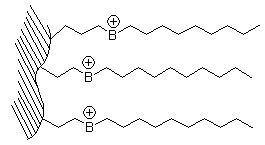
SIELC Technologies provides 4 types of different B-type columns with positively charged functional groups. Primesep B is a strong basic column. The recommended pH range is from 1 to 4.5, created by the addition of trifluoroacetic, phosphoric, perchloric, or formic acids to the mobile phase. Primesep B2 is a weak basic column with acidic carboxylic functional groups. At pH of the mobile phase below 5, the acidic groups are not ionized and B2 column surface becomes positively charged. This dual chemistry offers extended pH range from 1 to 6.5, suitable for the ammonium acetate and ammonium formate buffered mobile phases. Primesep D column, originally developed for direct plasma analysis, became very useful for other anion-exchange/reverse phase applications. It has а pH range from 1 to 4.5 and offers similar properties as Primesep B2 column but the column has no carboxylic groups and remains positively charged throughout the working pH range. The fourth column, which offers anion-exchange properties, is Primesep AB column. This column also offers cation-exchange properties and is useful in separation of complex mixtures of polar anionic and cationic compounds. |
|
Primesep B columns retain acid residue in the stationary phase in equimolar amount. When a column switches to the mobile phase with another type of acid, it should be sufficiently equilibrated to replace all counter-ions from the previous mobile phase with new counter-ion. |

© SIELC Technologies. 2002 - 2026
Sign up to our newsletter
Contact
Address: 804 Seton Court, Wheeling, IL USA 60090
Tel: (847) 229-2629 | Fax: (847) 655-6079
Sales, Refund and Returns Policy
Email: mail@sielc.com | Sitemap
Host a Customized Seminar at Your Company
Delivering tailored seminars directly to your team.
